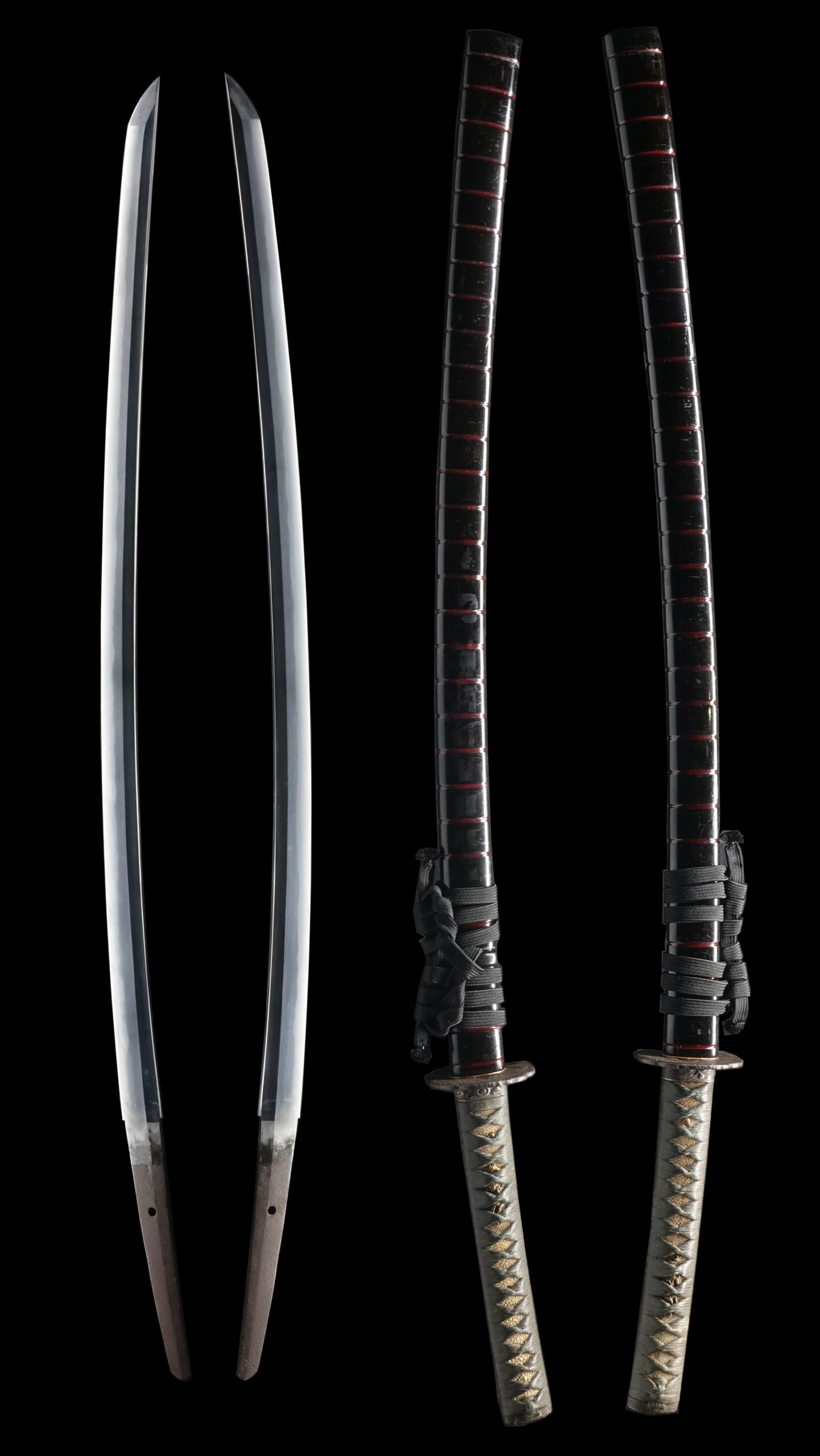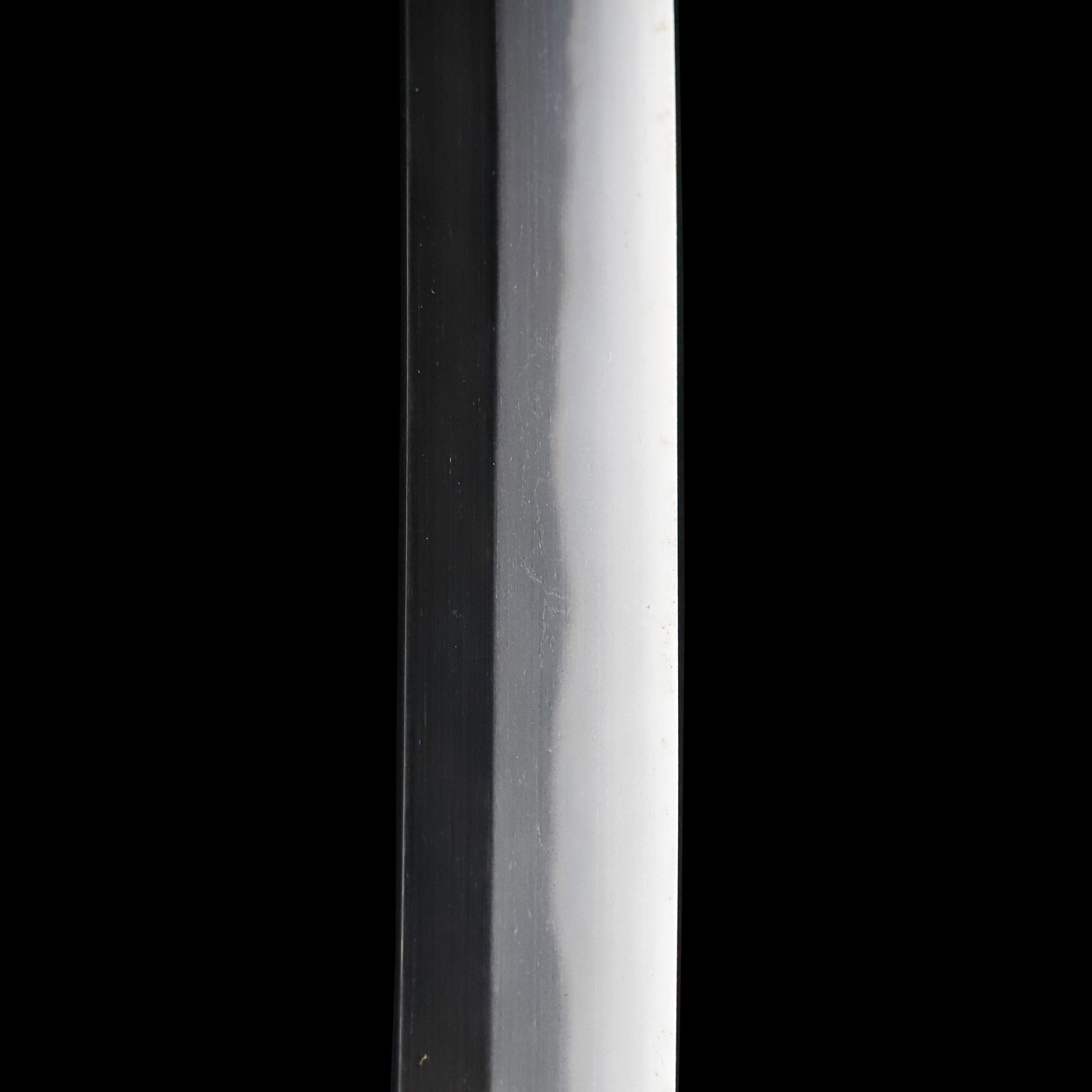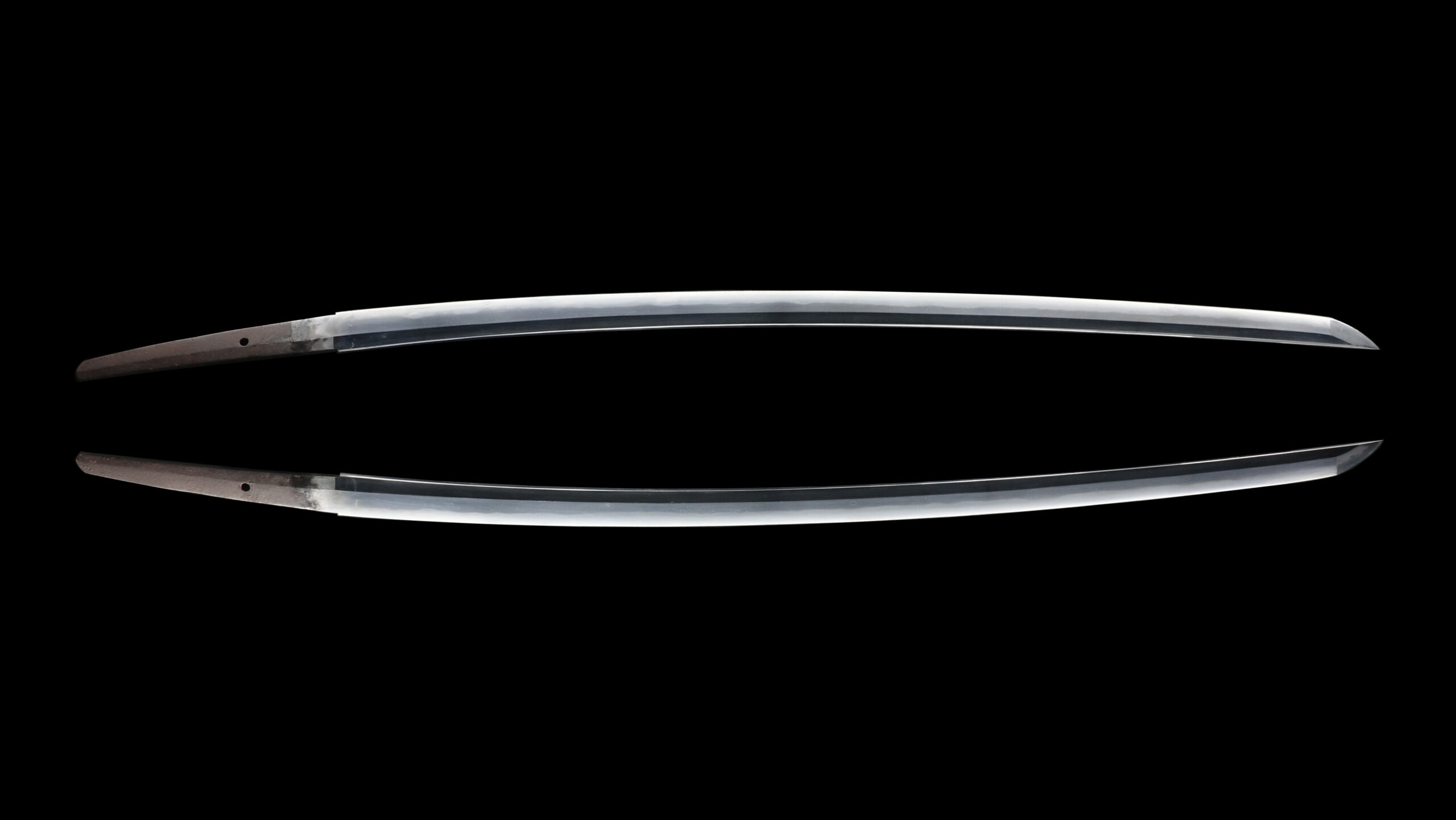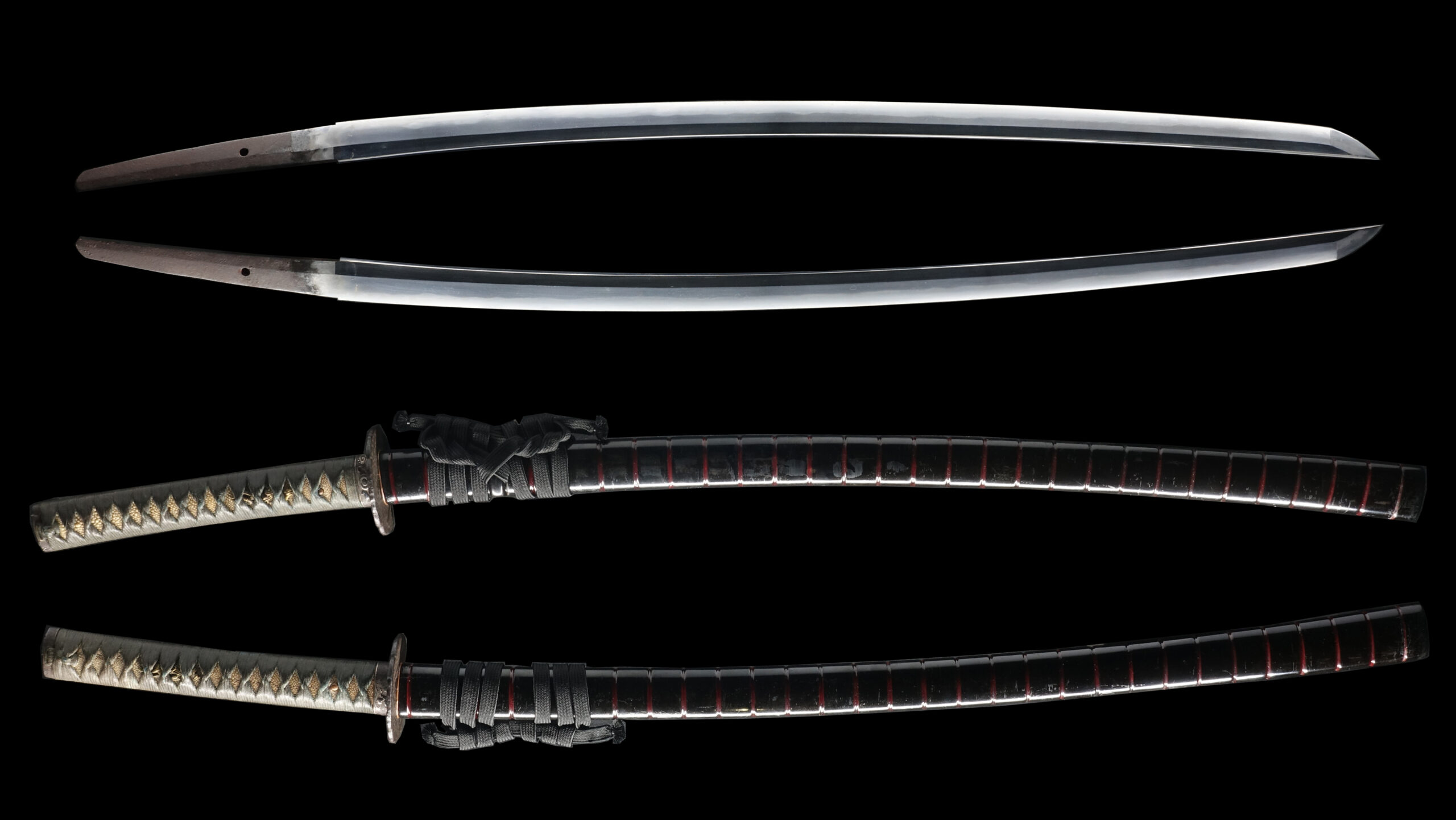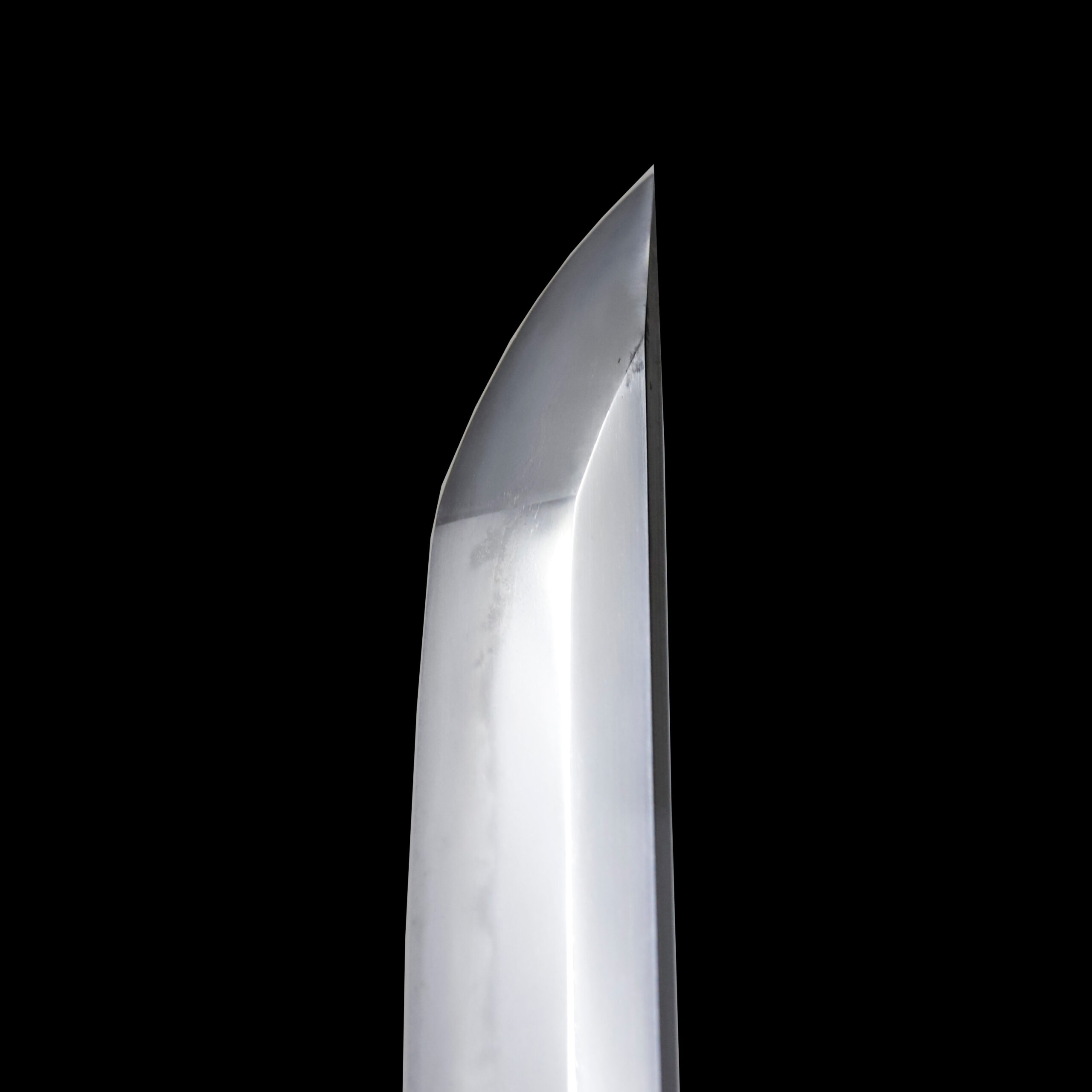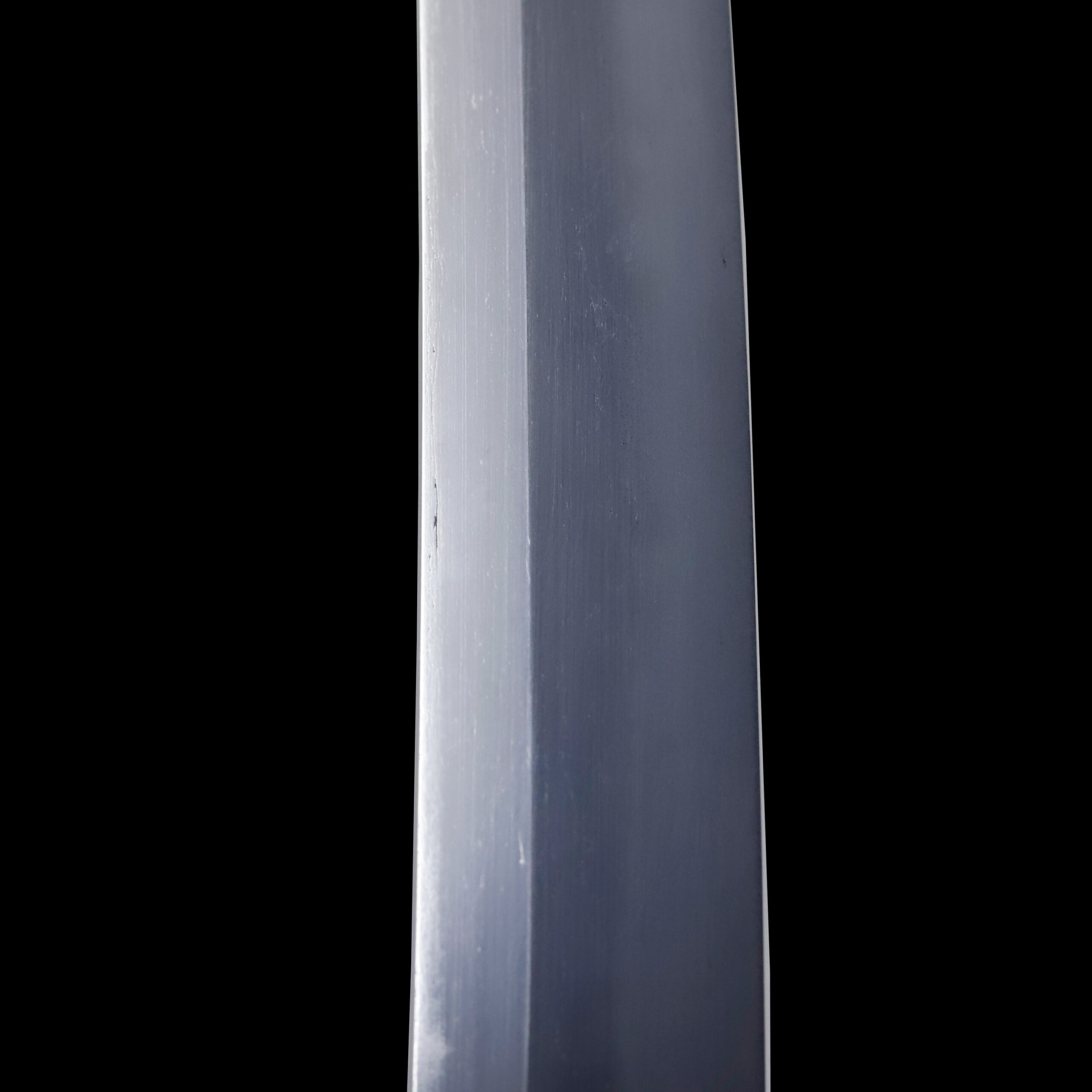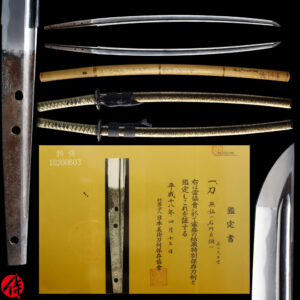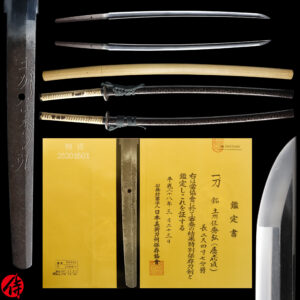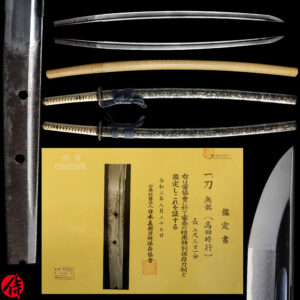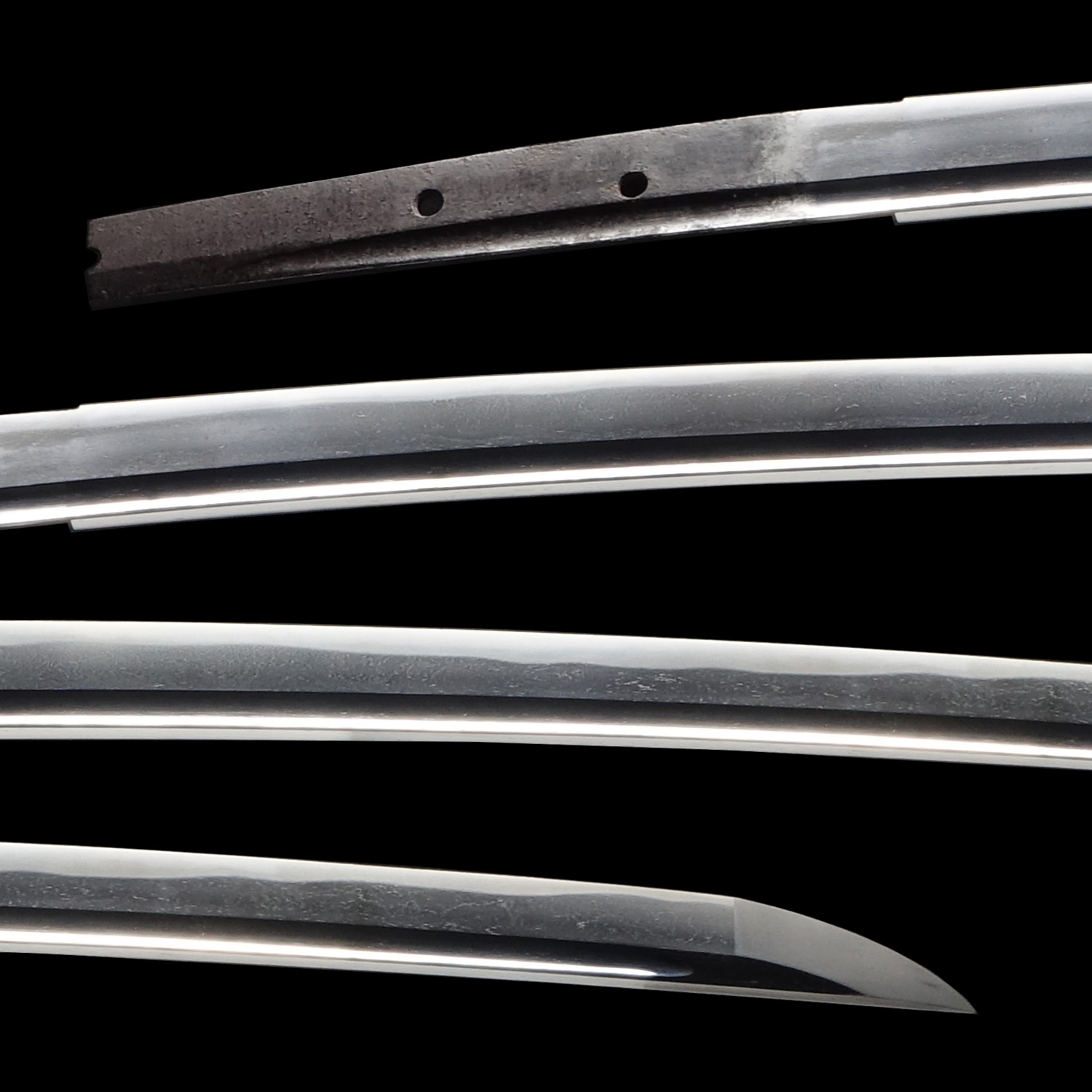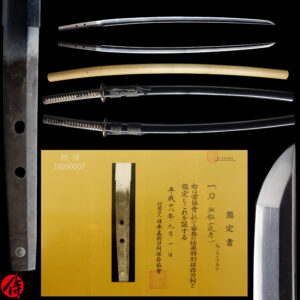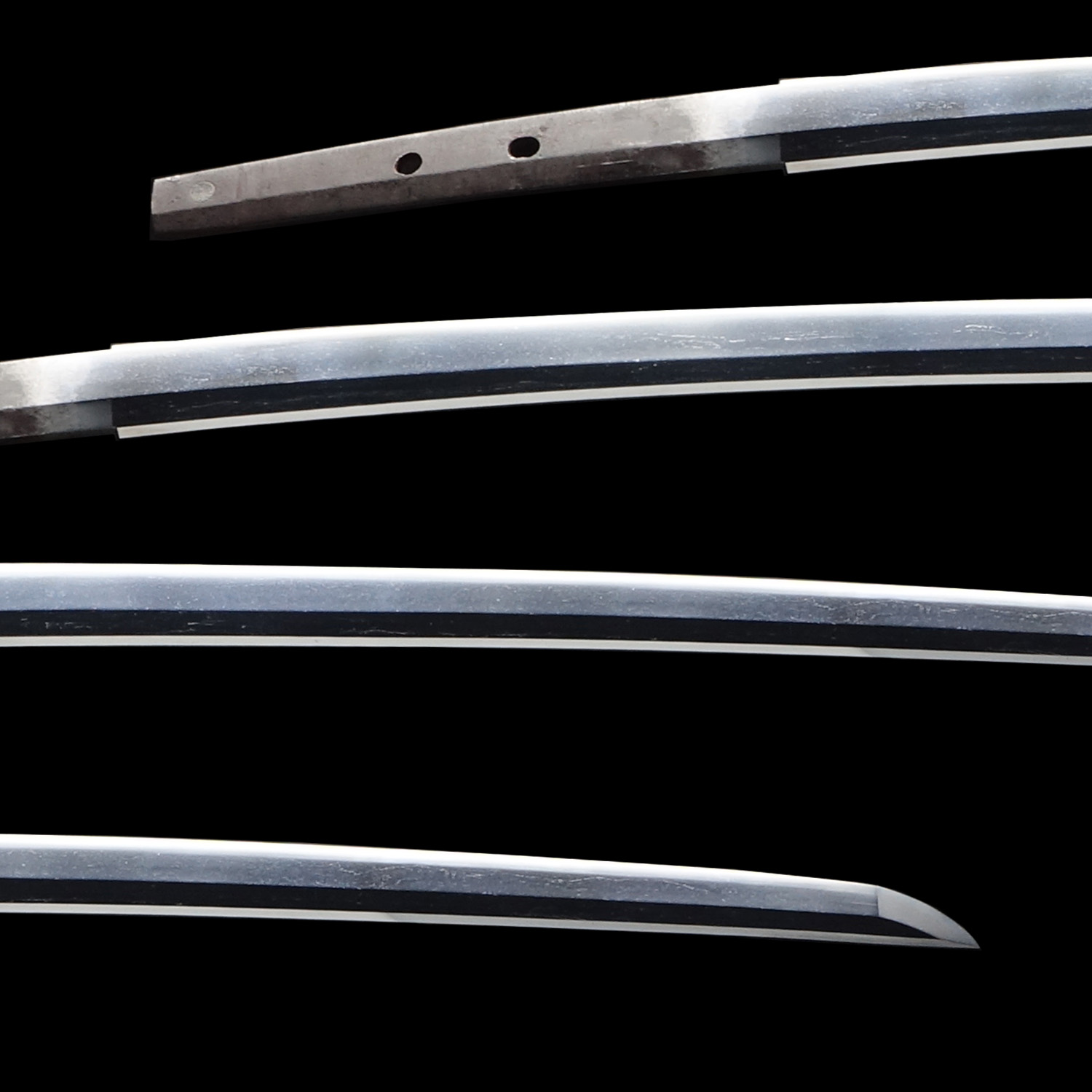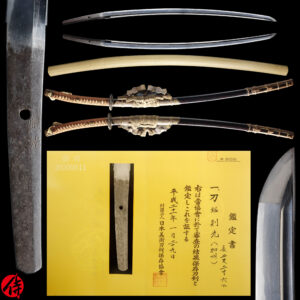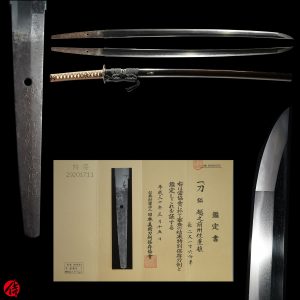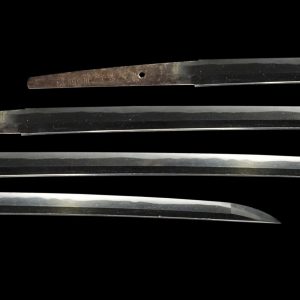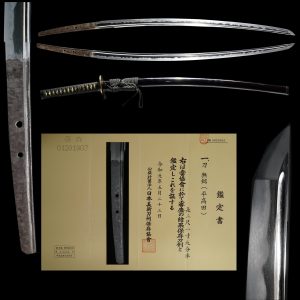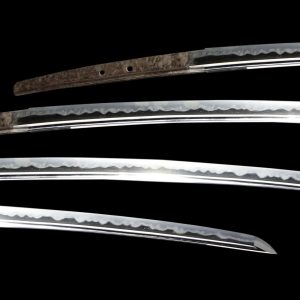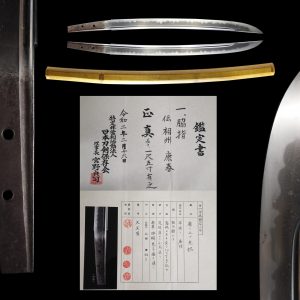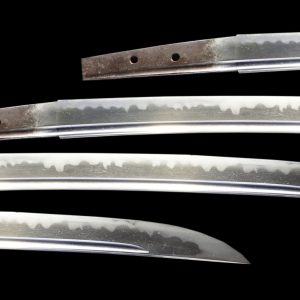Antique Japanese Sword Katana attributed to Unju Nobukazu with NBTHK Hozon Certificate
【Description】
Summary
This blade is attributed to Unju Nobukazu (運寿信一), who was active at the end of the Edo period (1860-1865). He was an apprentice of the 7th-gen Ishido Korekazu, one of the most famous sword makers in the late Edo period. Nobukazu learned sword-forging techniques from Korekazu in Azabu town in Edo City (Today’s Tokyo). He was also known as a Hanko for Ayabe domain (Today’s Kyoto). He exclusively served this domain. Ayabe domain was ruled by Kuki (九鬼) family, a navy that initially worked for Nobunaga Oda and Hideyoshi Toyotomi during the Sengoku Jidai(The warring state period). The family was prestigious, and they were depicted as a pirate feudal lord in war chronicles during the Edo period (1603-1868). Because Nobukazu forged blades for this domain, his craftsmanship must have been highly acknowledged by the Samurai living there.
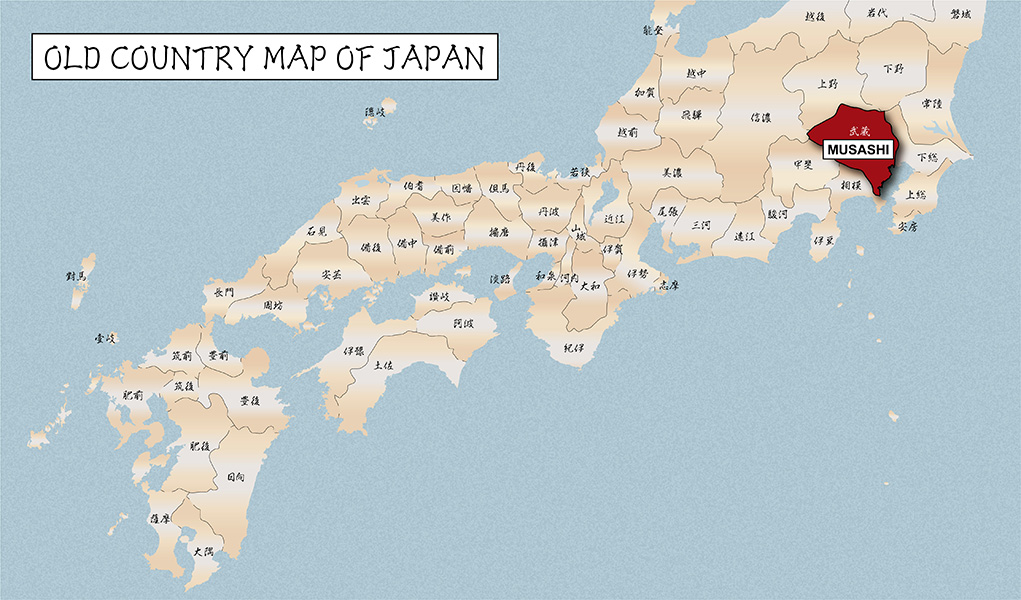
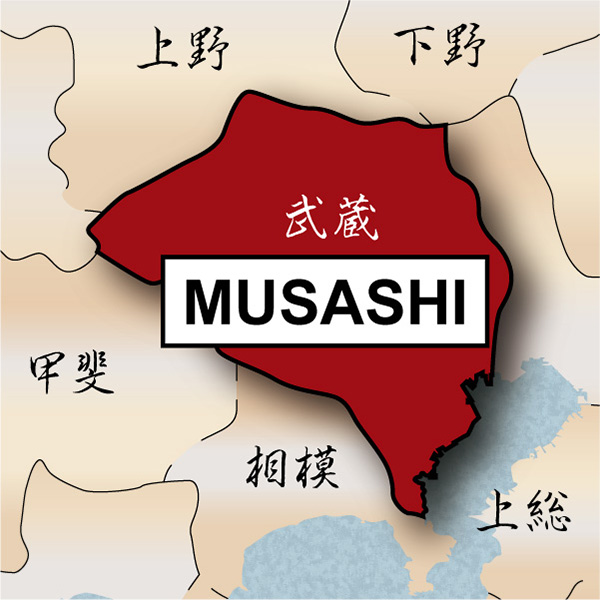
7th Gen Korekazu (His master)
The seventh-gen Korekazu, who was active at the end of the Edo period, is especially highly regarded among Japanese sword experts because of his superb craftsmanship. The 7th-gen Korekazu is also known as Unjyu Korekazu.7th-gen Korekazu’s real name is Masataro, and he was born in 1820 and learned the sword-forging technique from his uncle Kato Cho Unsai Tsuna Toshi, who lived in Dewano Kuni(Today’s Yamagata prefecture).Later on, he became a son-in-law of 6th-gen Ishido Korekazu and eventually took over Edo Ishido school. Seventh-gen Korekazu forged swords up until the early Meiji period. He died at the age of 75 in the 24th year of the Meiji era.
The 7th-gen Korekazu was ordered to forge a sword for Ise Shrine in Mie prefecture and Toshogu Shrine in Tochigi prefecture. And he was allowed to inscribe the Tokugawa family emblem on these swords. Furthermore, in 1854, he was ordered to forge a sword for sending to the USA and created Naginata for the UK, which was gifts from Japan for diplomatic relations. This fact indicates that Korekazu was one of the Edo government’s trusted swordsmiths and played an essential role at the end of the Edo period.
The 7th-gen Korekazu was a great master as well because he trained quite a few renowned swordsmiths, such as Unju Nobukazu. His sword style is called Bizen-Den, and he was great at forging blades with Choji Midare Hamon, which makes Bizen DEN special. His master also used Unju as his title. And it is said that Nobukazu received permission to use this title. Considering this fact, Nobukazu was one of the most trusted apprentices and his craftsmanship was highly appreciated by the master as well.
This blade is appraised as a Hozon Touken (保存刀剣) issued by NBTHK (Nihon Bijutsu Touken Hozon Kyokai: 日本美術刀剣保存協会). This authentication paper was only given to authentic Japanese swords, well preserved and high quality with artistic value.
*Please keep in mind that there are a couple of minor Kitae kizu on this blade If you like to know more details, please feel free to contact us.
【Blade】
Cutting Edge Length (Nagasa): 68.7 cm ( 27.0 inches)
Curvature (Sori): 1.9 cm (0.75 inches)


Hamon:
The crystalline structure which forms along the cutting edge of a blade as a result of the hardening process.
Jimon (Jihada):
Visible steel surface pattern created by folding and hammering during forging process.
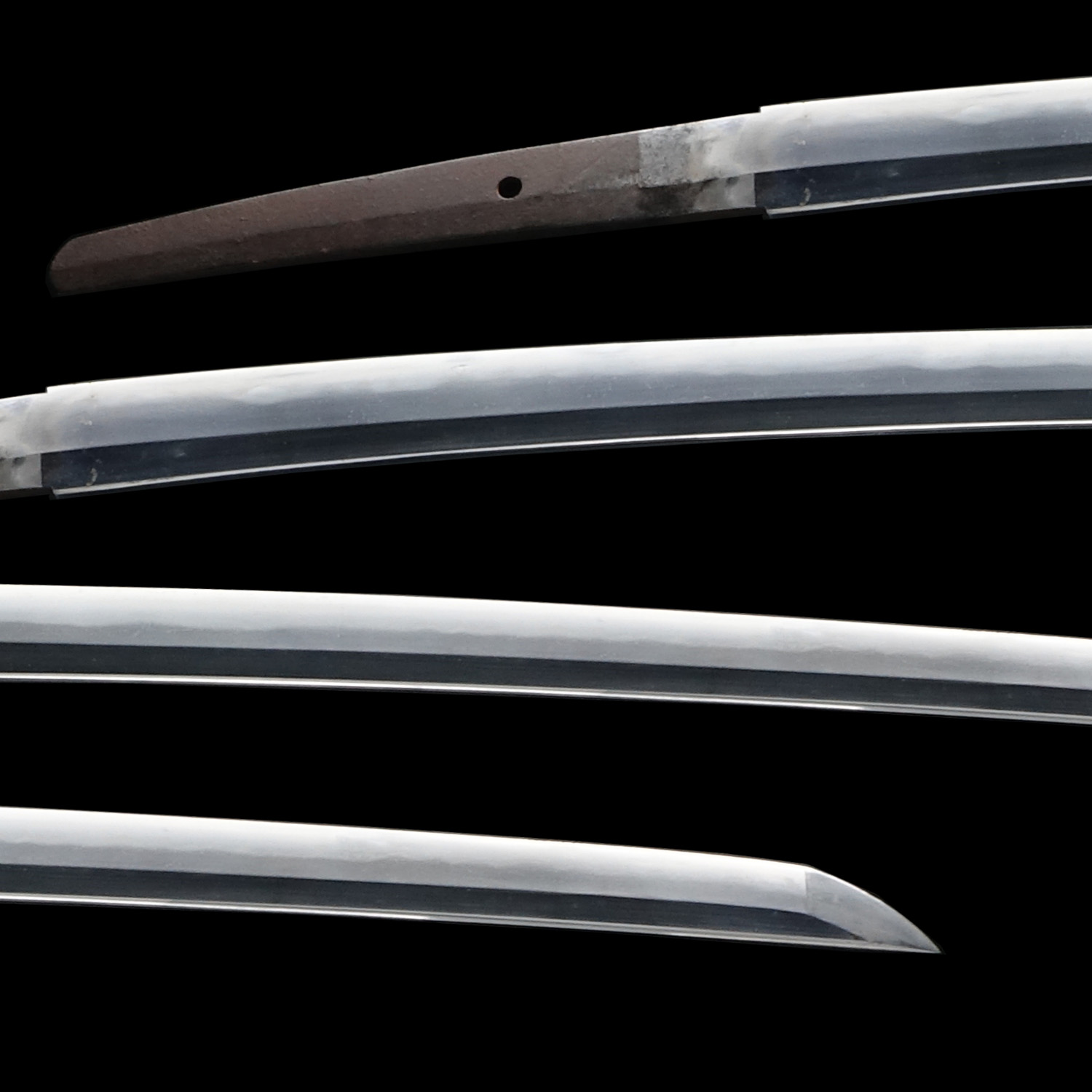
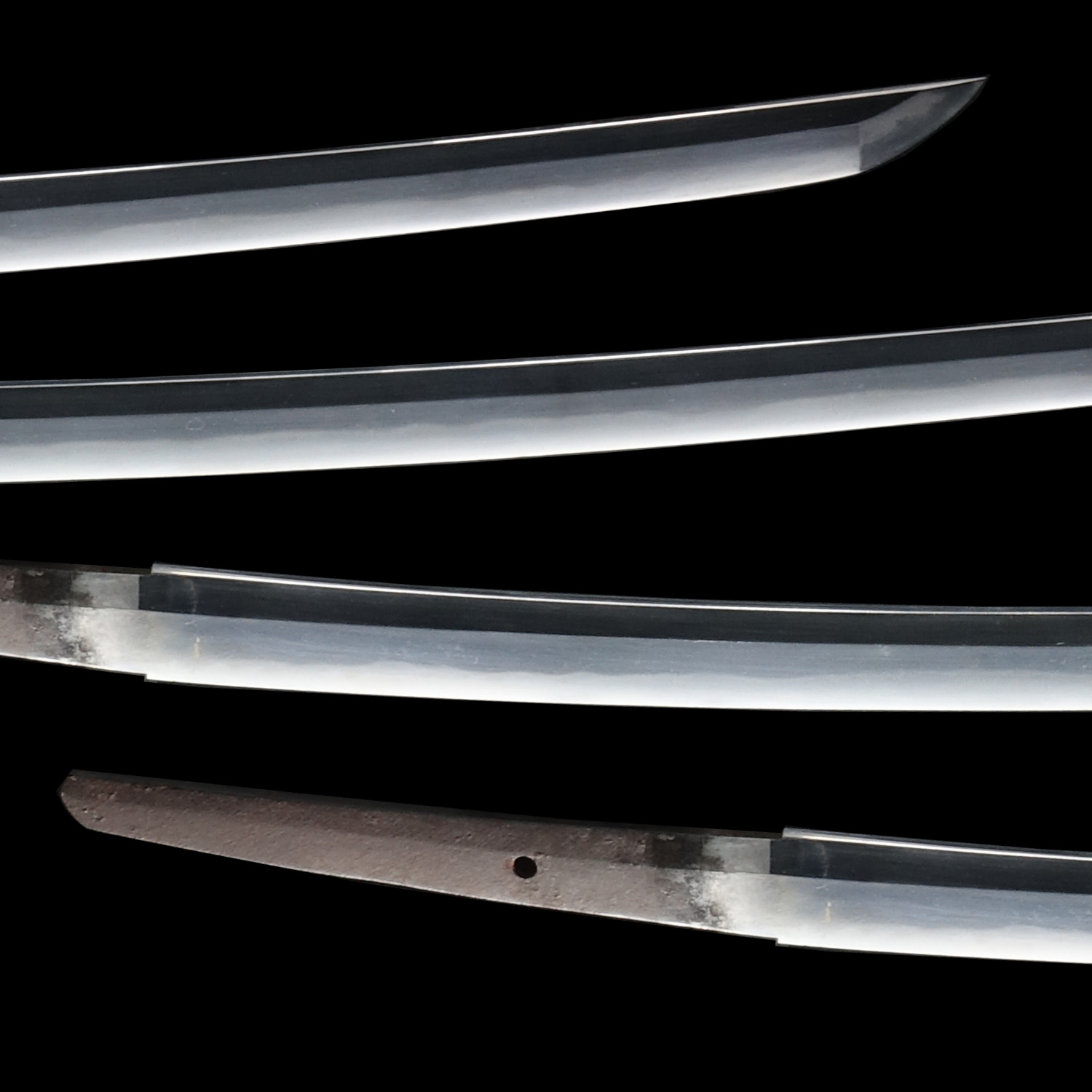

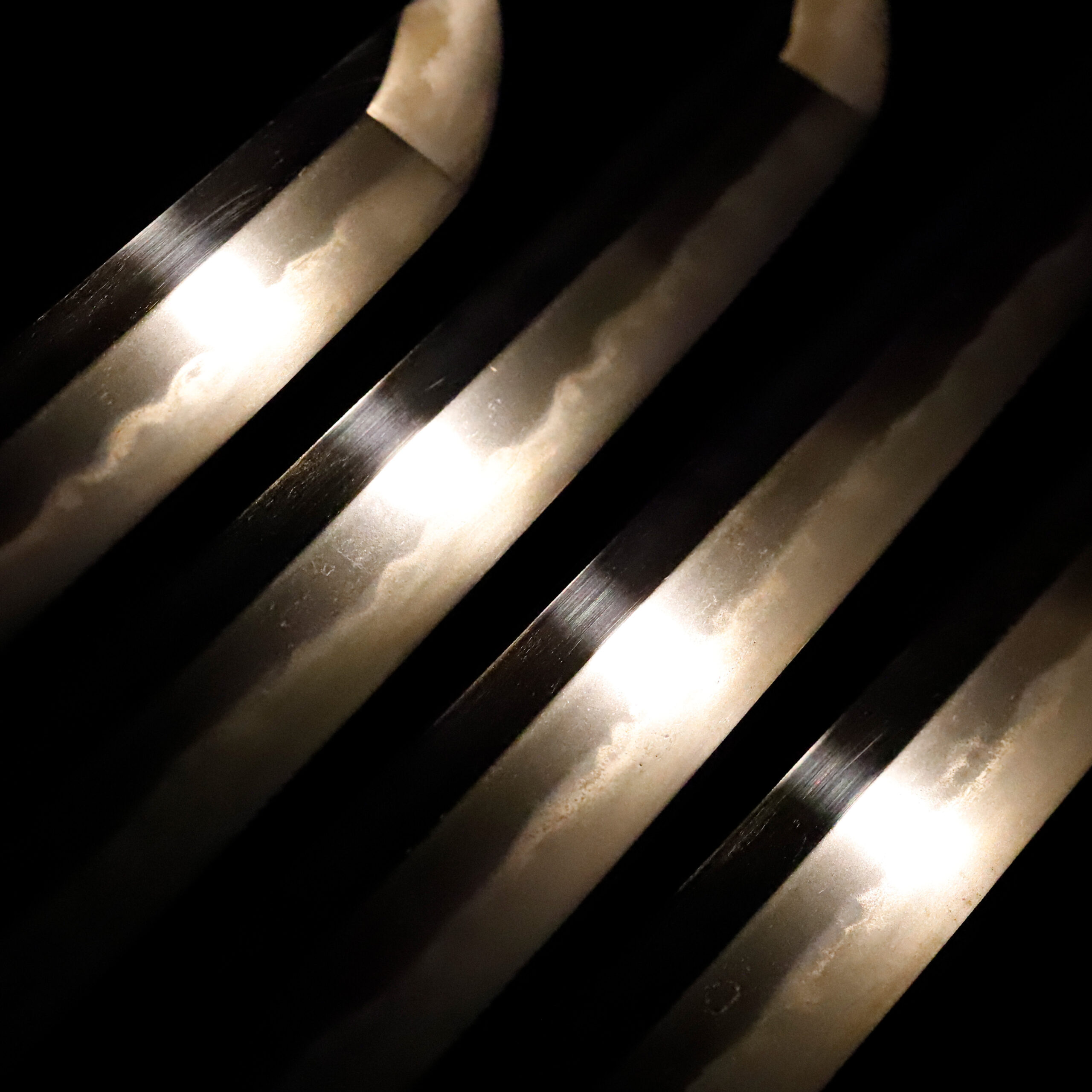
Nakago: Nakago is the tang of the Japanese sword.
Japanese swordsmiths left the black rust on the tang because it prevents red rust while the tang is in its handle. And the discoloration of the tang was created over time, and it is a great indicator for a Japanese sword specialist to estimate when the sword was forged.

Koshirae: Koshirae is the mounting of the Japanese sword. There are several parts that consist of Koshirae such as Saya (Scabbard), Tsuka (Handle), Tsuba (Handguard).
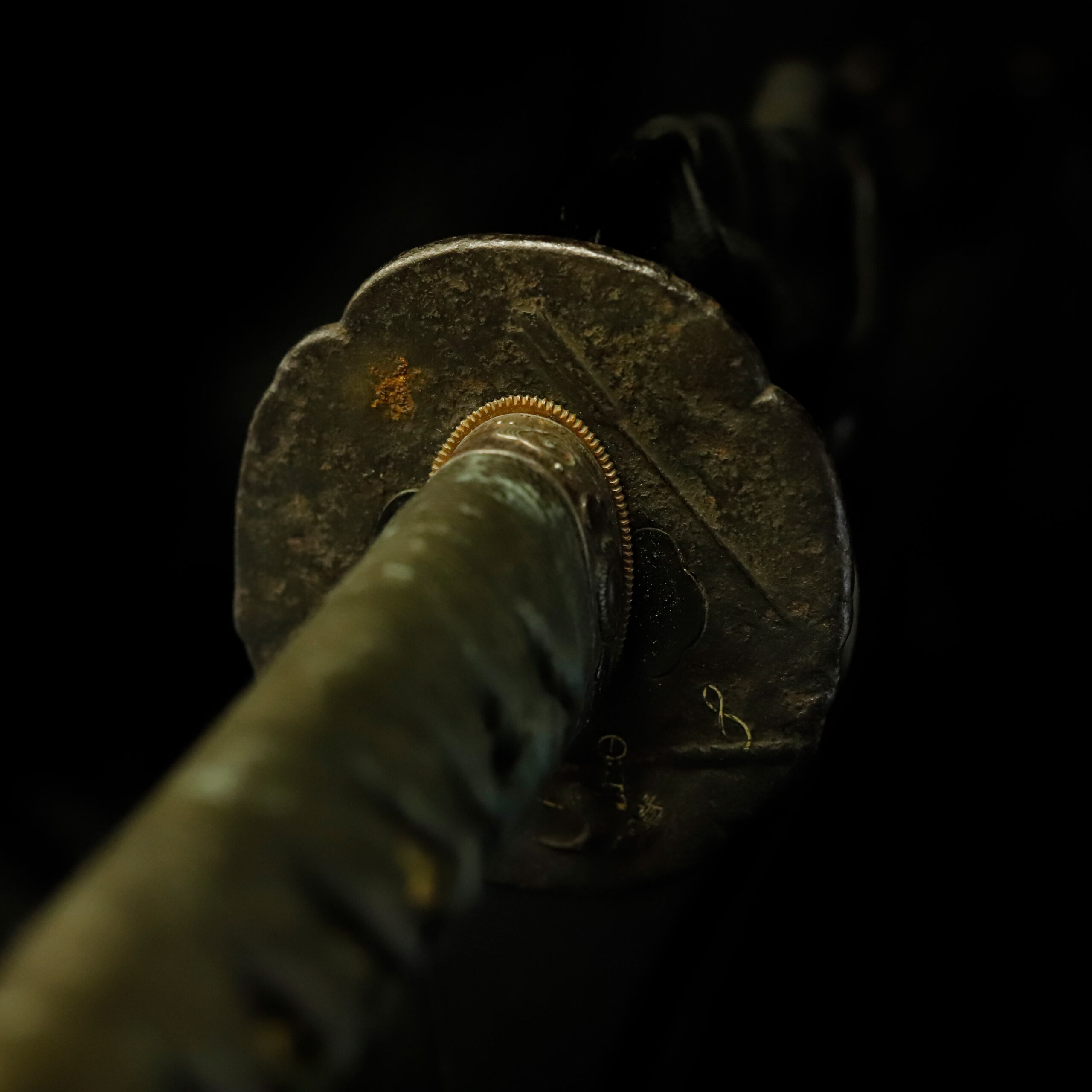
Fuchi-Kashira: A pair of matching sword fittings that cover the upper and bottom parts of its sword hilt.
We think the plant motif designed on this Fuchi Kashira is the Kiku (菊, chrysanthemum) flowers. A long time ago, chrysanthemums were used as a medicine for obtaining a long life in the continent, and it was brought to Japan with this thought in the Nara period (648-781). Chrysanthemums symbolize autumn, and people have greatly appreciated it since ancient times. Since its petals form radially, the chrysanthemum has been likened to the sun. That is why this flower pattern is treated as the symbol of perpetual youth and longevity or good health.
There is a popular design that is called Kikusui Mon (菊水紋). It depicts chrysanthemum flowers floating in running water. Since a long time ago, the Kikusui Mon has been known as a design that represents longevity based on a Chinese legend. It says we could extend our lifespan by drinking water flowing from the chrysanthemum colony. Therefore, people treated this design as a kind of good luck motif. It is said this pattern started to be used in the Kamakura period (1185-1333). We could find a combination of chrysanthemum and water (wave) patterns. This Fuchi Kashira’s design might be able to be categorized in the Kikusui Mon.
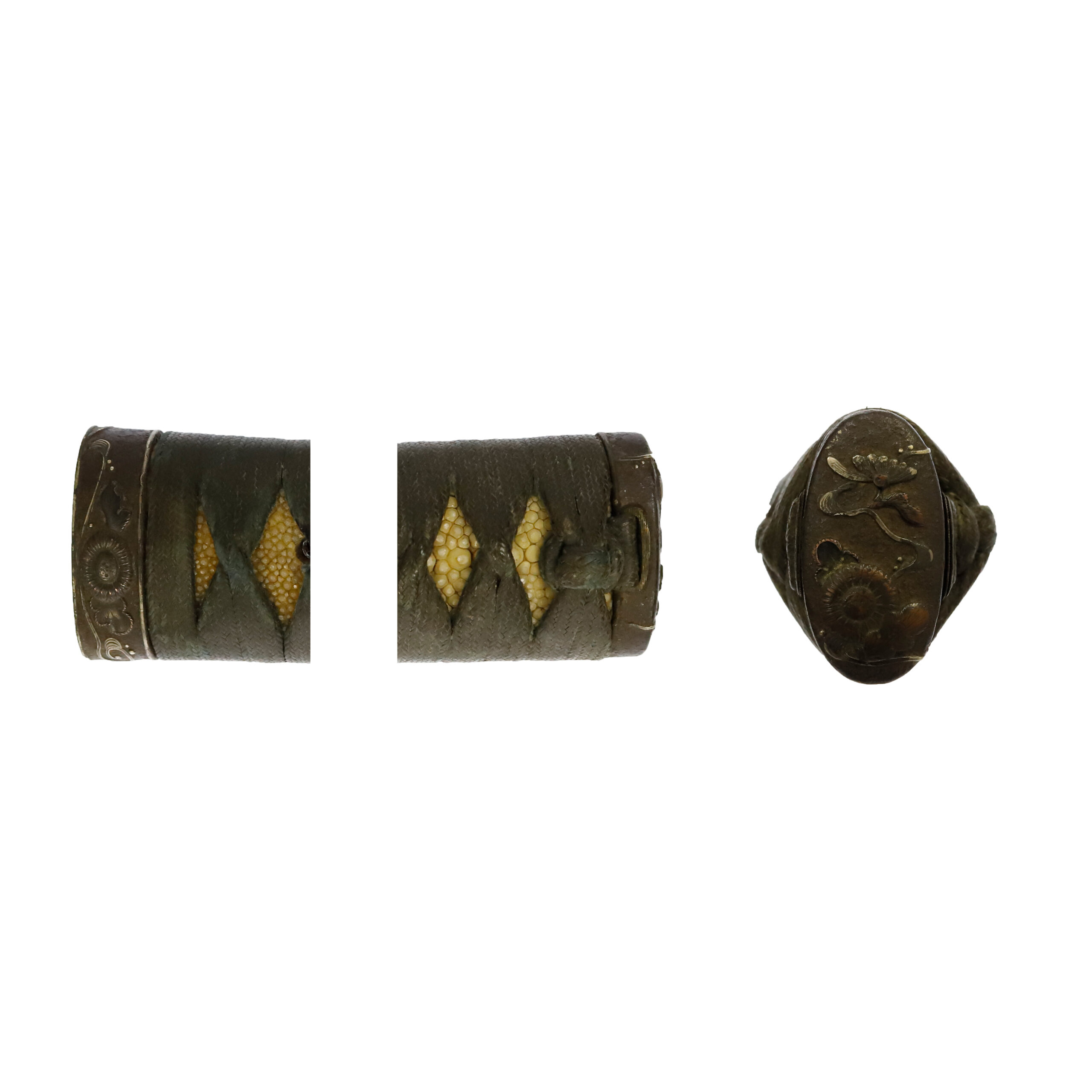
Tsuka and Menuki: Tsuka is the handle of the Japanese sword and Menuki is its decoration.
You would see the figure of a dragon-designed Menuki on each side of the handle. While some coloring of its surface has already faded due to aging, it seems golden paint was originally applied. Initially, dragons were imaginary creatures found in ancient foreign traditions and myths. Furthermore, it is regarded as a symbolic beast of auspicious signs. Its body is likened to nine animals: antlers are deer, the head is a camel, eyes are demons, the neck is a snake, the belly is the Mizuchi (蛟, a mythical animal in Japan that looks like a snake and has a horn and four legs), scales are fish, claws are falcons, palms are tigers and ears are cows. It was thought that the dragon would reign at the top of all animals because of its odd-looking appearance. There are lots of sword mountings with dragon designs. It shows that many Samurai warriors favored this dignified beast motif.
If you focus on the upper side Menuki’s dragon hand, you will find that it brings a ball-shaped object in their hands. This item is the Nyoi Houju (如意宝珠, Cintāmaṇi), a fantasy jewel that fulfills any desire and gives out treasure, clothes, food, and drinks. Moreover, it heals illness and suffering, removes evils, purifies muddy water, and prevents disasters. It is said this magical item is taken from the brain of the dragon king.
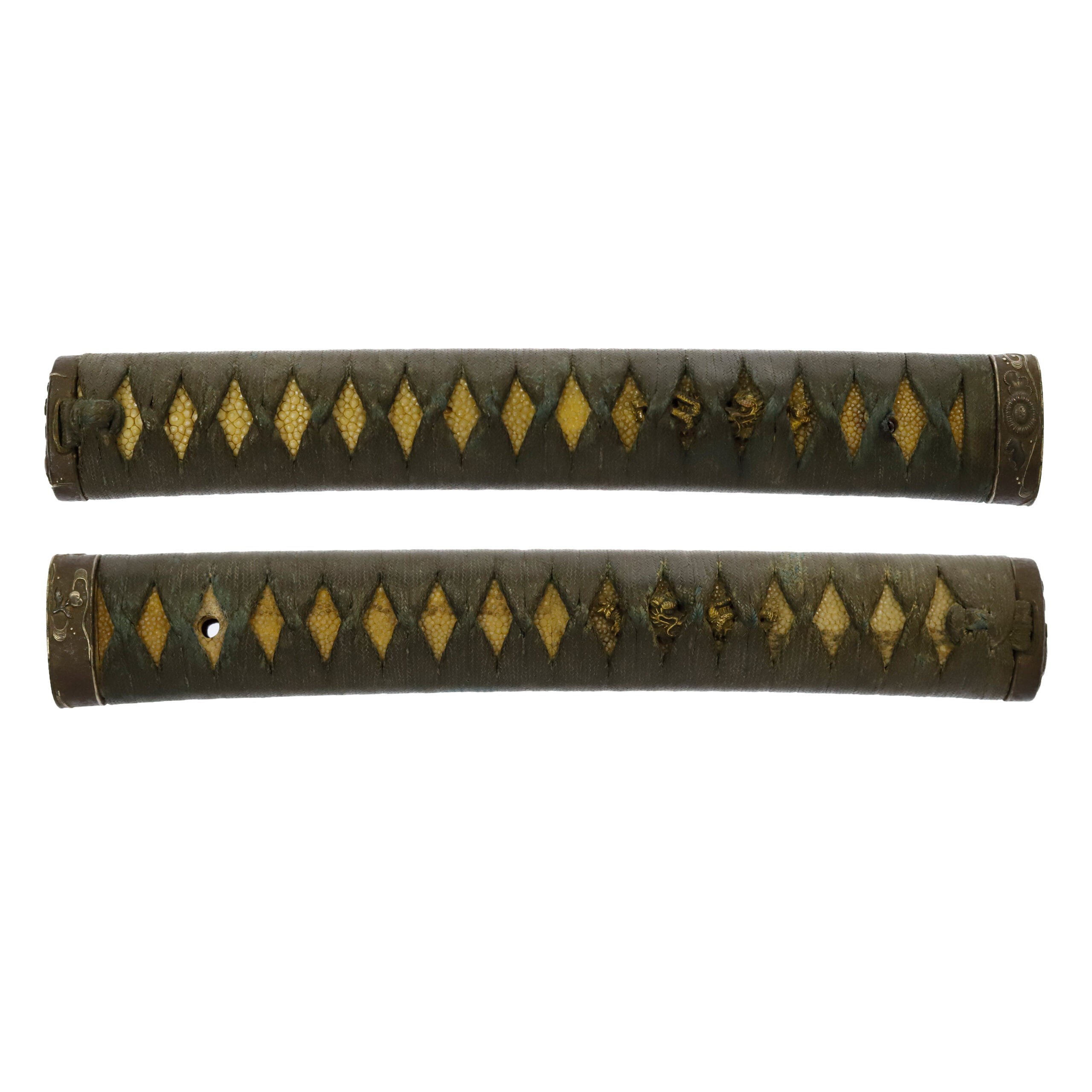
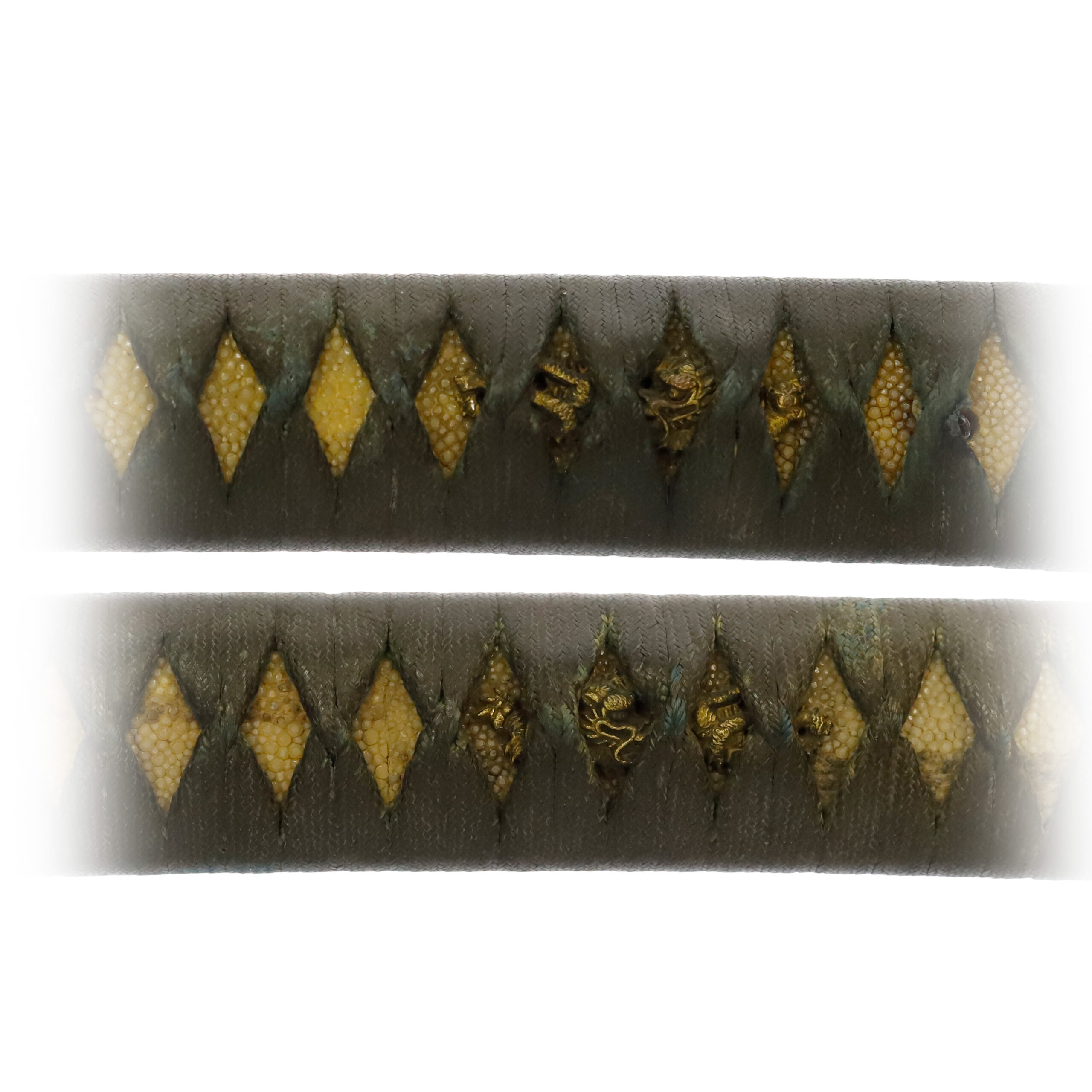
Tsuba and Habaki: Tsuba is the handguard for the Japanese Sword and Habaki is the equipment to make the blade not touch its scabbard inside. It prevents the blade from getting rusty and chipped.
This antique iron Tsuba has Yotsu-Mokkou (四ツ木瓜) shape. The motifs designed on this Tsuba are related to the Samurai culture. We could find an arrow on both sides. Bows and arrows are projectile weapons that were created as a tool for hunting elusive prey during the evolution of humankind as they entered the stage of hunting. Since ancient times, arrows have been used as a weapon, which is the original purpose of this item. Additionally, each home displayed decorated arrows wishing it would exorcize evil spirits in houses. This talisman is called the Hama-Ya (破魔矢) in Japanese, and this custom is still kept today. Many Samurai warriors loved the arrow pattern as an arrow goes straight forward powerfully.
You would find an Abumi (鐙, stirrup) on the front of this Tsuba. It is a type of harness, a tool that hangs on the horse’s side and puts the foot on when riding. And stirrups are used with the Kura (鞍, saddle). It is a device worn on the back of a horse to allow it to sit on the horse. In addition, we could find a cane or stick-like object is depicted behind the stirrup. It is possibly a Shikomi Gatana (仕込み刀), which is a kind of hidden weapon.
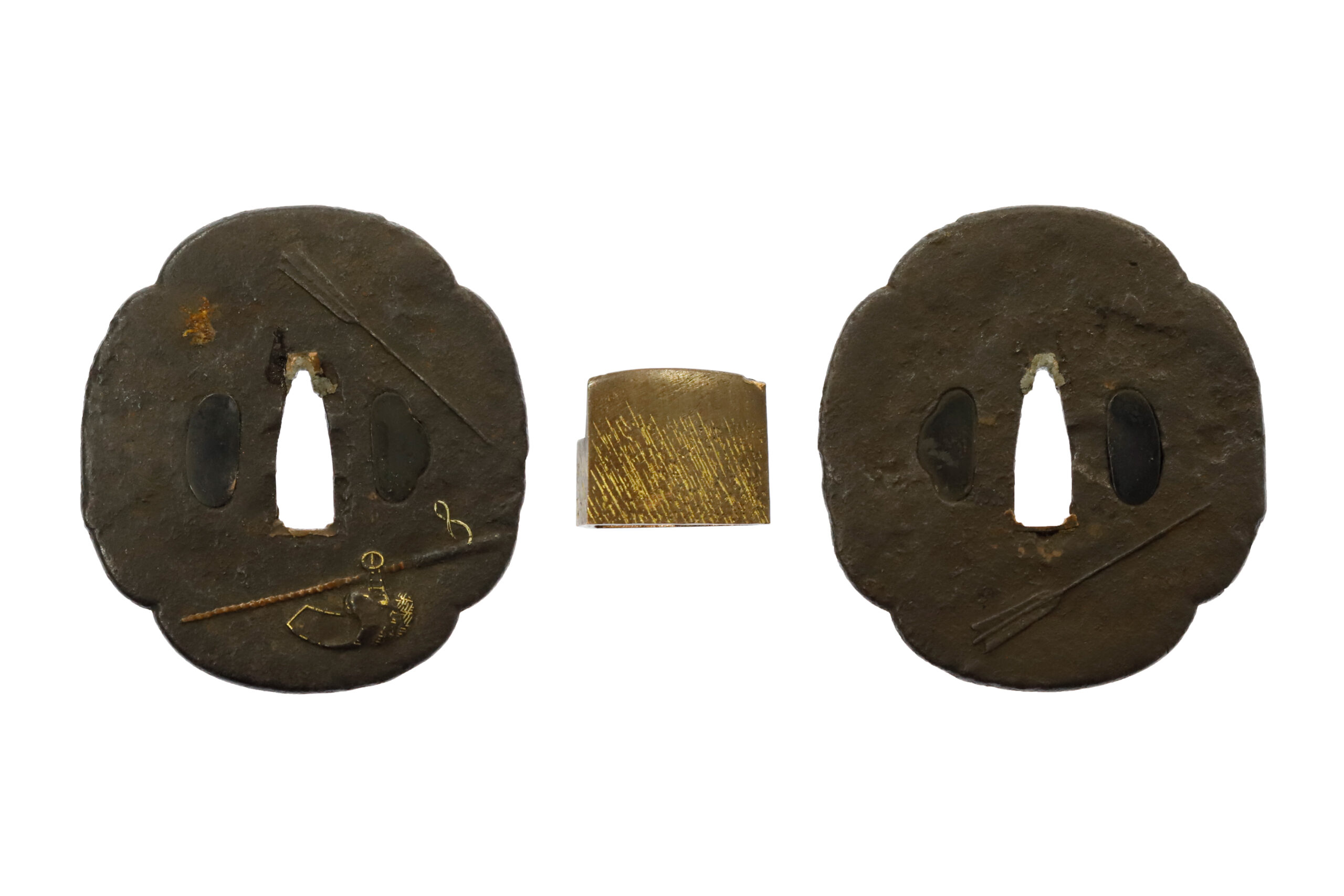
Saya: Saya is the scabbard for the Japanese sword.
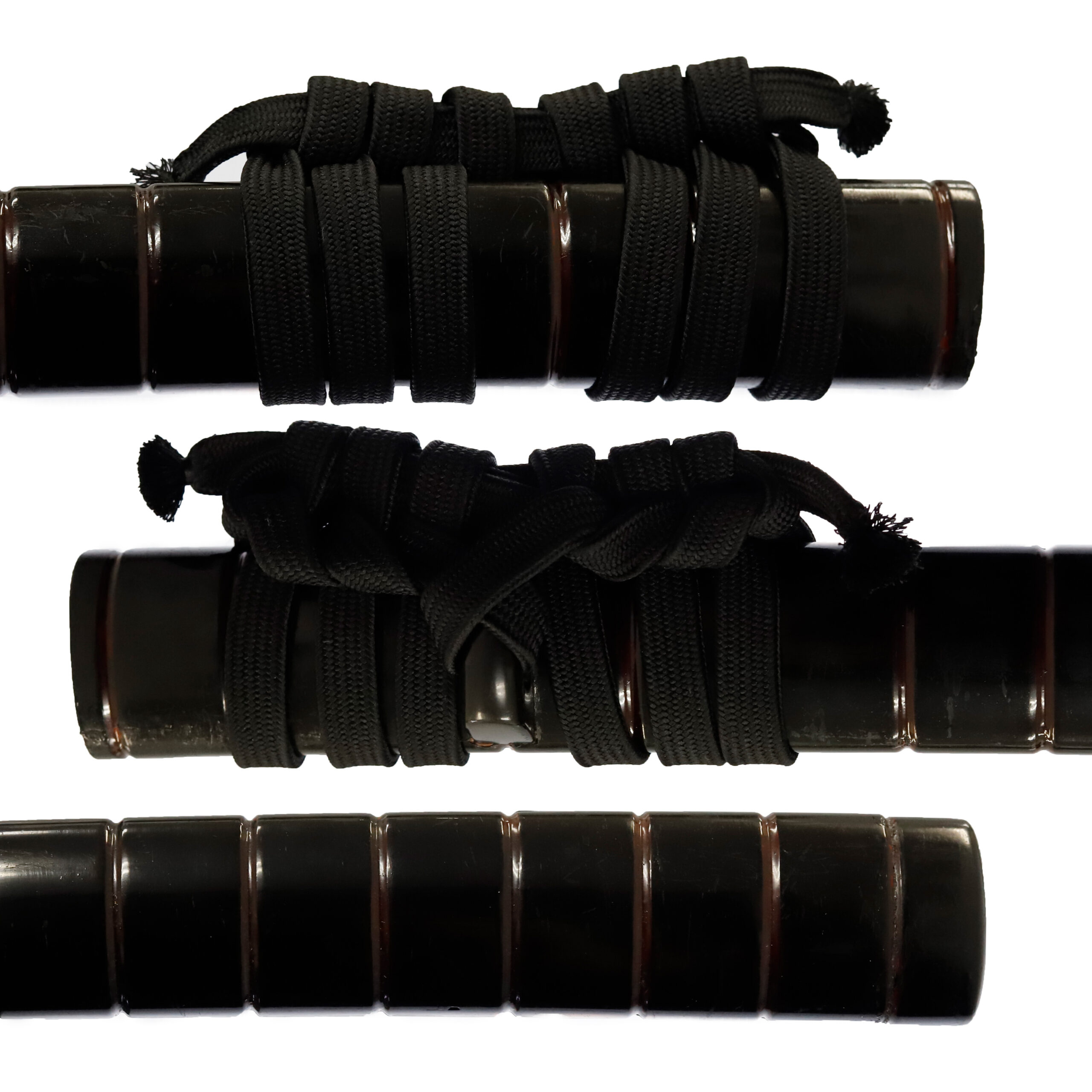
Authentication Paper: NBTHK Hozon Certificate for the blade (No.3021352)
NBTHK, also known as Nihon Bijutsu Touken Hozon Kyokai (the Society for the Preservation of the Japan Art Sword), is one of the oldest Japanese sword appraising organizations in modern-day Japan. They authenticated the blade on August 26th in the first year of Reiwa (2019). They appraised it as Hozon Touken, the blade worth preserving for Japanese society. The purchaser will receive this original certificate as well. We can also translate what is written into English and make a PDF file for your record if you request.
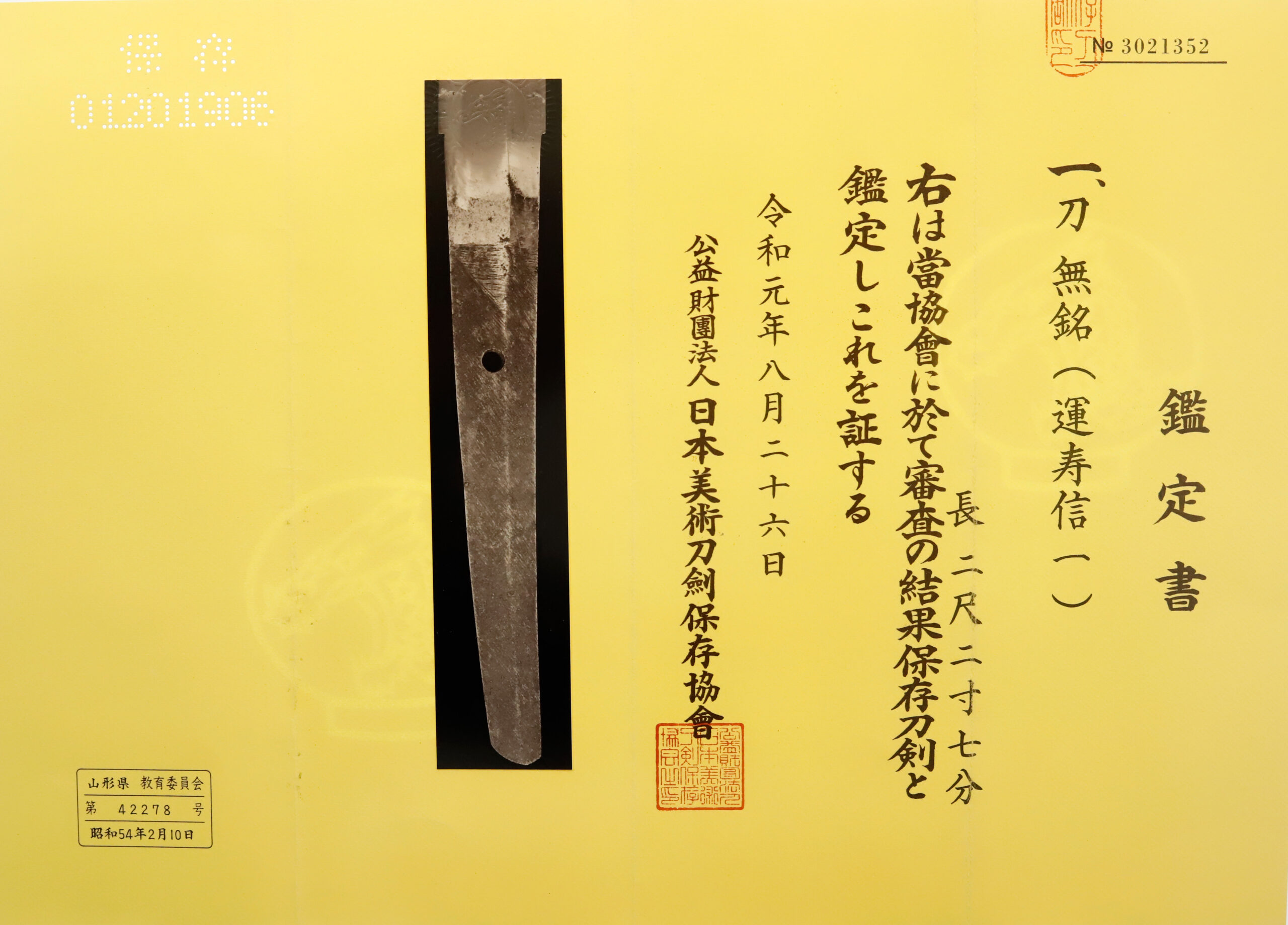
Registration Number: Yamagata 42278
The Board of Education in Yamagata prefecture issued a registration paper for this sword. It is called Jyu Token Rui Torokusho (銃刀剣類登録証). Bunkacho (The Agency for Cultural Affairs) acknowledges a Japanese sword with this paper as a work of art.
The sword needs to be traditionally hand-forged and made of Tamahagane carbon steel to be registered in the system. With this paper, its owner in Japan can legally own an authentic Japanese sword. Based on this registration number, we will apply for its export permit.
This paper will need to be returned to the board of education when the sword is being shipped abroad, but you can receive a copy of it. An English translation of this registration paper is available on request.

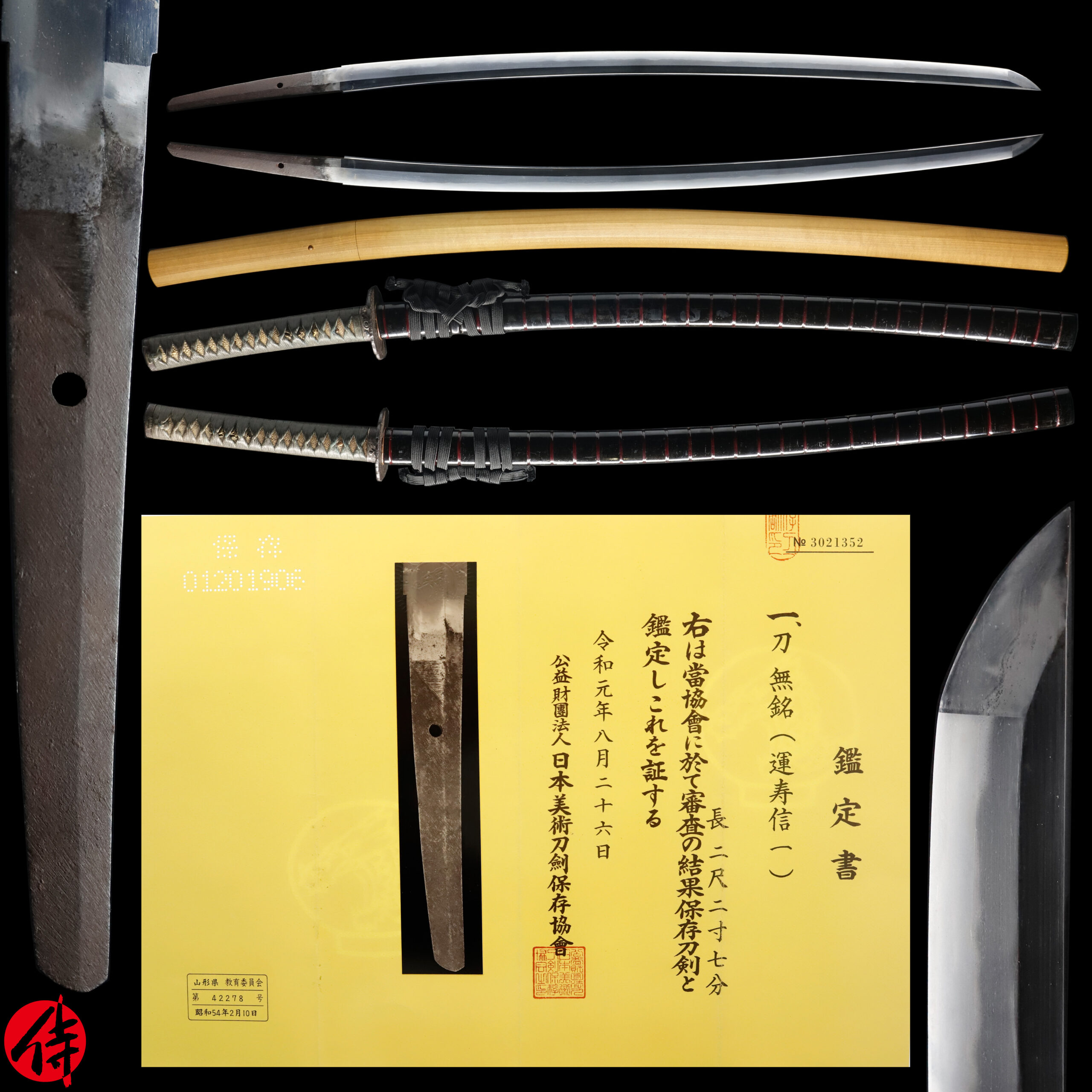
【About us】
Samurai Museum is located in Tokyo, Japan, exhibiting antique artifacts related to the Samurai history. Samurai Museum Shop is the place for those who are interested in Japanese culture and craftsmanship. We deal with antique Samurai swords/armor, traditional crafts made in Japan and so on.
【Japanese Sword& Export Process】
The Japanese swords we deal with are hand-forged edged swords made in Japan. It was made from the traditional carbon steel called TAMAHAGANE(玉鋼). Samurai Museum is familiar with the proper legal procedure for an antique/ authentic Japanese sword to be exported from Japan. We have sent more than 700 Japanese swords for the past few years (~2024) to amazing owners who appreciate its historical value.
Each Japanese sword is registered under the Agency for Cultural Affairs and the Board of Education in Japan. They issue a registration paper for each Japanese sword for its owner in Japan to legally possess it. The Japanese sword with its registration paper means it was traditionally hand-forged in Japan.
To legally export the sword from Japan to other countries, we will have to apply for its permit to the Agency for Cultural Affairs(Bunkacho) and return the original registration paper to the Board of Education. It normally takes around 2-4 weeks to receive this permit after submitting required documents. And we would like you to expect at least 1-1.5 months for your order to arrive at your given address after you ordered. For more detailed info, please click here.
It is allowed for residents in Japan to own authentic Japanese swords without a special license as long as they come with registration papers. Please feel free to contact us if you are a resident of Japan, whether temporarily or permanently. We will also assist you when you leave Japan and need to obtain the export permit.
【Payment Method】
We accept payment through Stripe (Credit card), PayPal, Apple Pay or ChromePay, all of which are secure payment methods. Also, you don’t need to make an account on Stripe for the checkout. If you prefer other payment method, please contact us. After confirming your payment, we will apply for an export permit. You may either pay in JPY, USD, AUD, CAD,EUR CHF or GBP. The price is set in Japanese Yen. Prices in other currencies are automatically calculated based on the latest exchange rate.

* If the amount is above 1 million JPY, Stripe or wire transfer will be the only options for payment.
【Shipping】
We have shipped authentic Japanese swords to the USA, UK, Canada, Mexico, Germany, France, Hong Kong and Australia. If you don’t live in these countries and like to order, please contact us first before making a purchase. We offer Free International Shipping as long as we can send antique Japanese swords by EMS.
We normally ship by EMS(Express Mail Service) provided by Japan Post. We will send you a tracking number for your order as soon as we hand it to the post office. We will put 100 % insurance on the shipping document without any extra charge. Based on the total amount, there might be a duty tax or other fee for you to pay, depending on the countries. We use package cushioning to protect the item and put it in a PVC pipe, which is one of the most secure packages because of its durability.
It will normally takes 5-14 days for the item to arrive at your given address after we dispatch it. Time of delivery is estimated as accurately as possible by the carrier but does not take into account any delays beyond our control such as by inclement weather, post office holiday seasons.
* If you live in Australia and like to purchase an authentic Japanese sword, please click here to know the detail.

【Review】
Here is one of the reviews we received from a customer who purchased an authentic Japanese sword from us. For more reviews, please click here.
“My experience overall with the whole process was wonderful. I had many questions about the history and process to purchase these treasures. All my questions were answered very timely and complete. The staff is very knowledgeable and very well versed if any questions do arise.”
【How to make sure the condition】
Please keep in mind that what you are going to purchase is an antique item. We uploaded high resolution photos for you to check its condition thoroughly. If you like to see more photos with different angles, please feel free to contact us. We will be happy to send them to you so that you can make informed decision. It is essential for us to know that you are happy with your choice of a sword. and we are prepared to use the best of our ability to serve you.
【How To Contact Us】
Please contact us through email, Facebook Messenger or Live Chat if you have any questions. You can find each icon on the right side of the website. Please click one of them to reach us. We will reply to you within 1-2 business days.
【The Art of Nihonto (Japanese Sword)】
Samurai’s history is a profound, eloquent legacy of ancient Japanese warriors in which millions of people worldwide are being fascinated. If you like to find out the art of Nihonto, please click here.
【A Guide to Japanese Sword Maintenance】
After acquiring an genuine Japanese sword, it is also important to know how to take good care of it. Here is the special video for you. Mr. Paul Martin, Japanese sword expert, shows you how to give proper maintenance to your sword. By mastering how to clean the Japanese sword, its aesthetic beauty will last forever.
When you purchase a Japanese sword from us, you can get a Free Japanese sword maintenance kit. It comes with four tools(Choji Oil, Uchiko Whetstone Powder, Peg remover, Oil Applicator). By watching the video instruction above , you can enjoy learning how to maintain your Japanese sword while appreciating it. If you have any difficulty assembling the sword or cleaning the blade, you can feel free to contact us.


MORE ANTIQUE JAPANESE SWORD FOR SALE
SWORDS WITHOUT CERTIFICATES FOR SALE
LEARN JAPANESE SWORD TERMINOLOGY
Thank you for reading all the information on the page. If you have any difficulty choosing the right Japanese sword for you, we will be more than happy to help you find the one that speaks to you the most. Please feel free to contact us.

